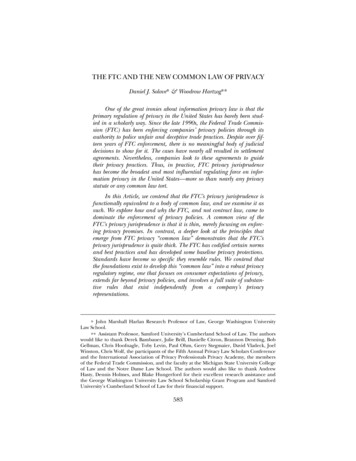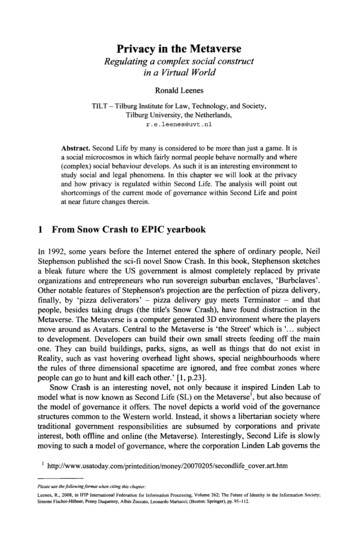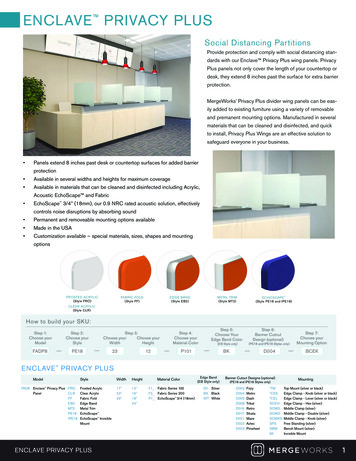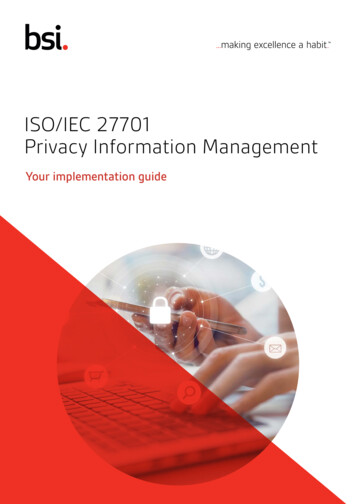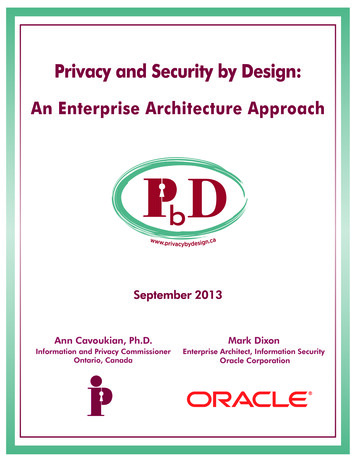
Transcription
Privacy and Security by Design:An Enterprise Architecture ApproachSeptember 2013Ann Cavoukian, Ph.D.Mark DixonInformation and Privacy CommissionerOntario, CanadaEnterprise Architect, Information SecurityOracle Corporation
Information and Privacy CommissionerOntario, Canada2 Bloor Street EastSuite 1400Toronto, OntarioM4W 1A8Canada416-326-33331-800-387-0073Fax: 416-325-9195TTY (Teletypewriter): 416-325-7539Website: www.ipc.on.caPrivacy by Design: www.privacybydesign.ca
Privacy and Security by Design:An Enterprise Architecture ApproachTABLE OF CONTENTSForeword. 11. Introduction. 32. Foundational Principles of Privacy by Design. 53. Foundational Principles of Security by Design. 73.1 Proactive not Reactive; Preventative not Remedial.103.2 Secure by Default.113.3 Embedded into Design.123.4 Positive-Sum, not Zero-Sum.143.5 End-to-End Security.153.6 Visibility and Transparency.173.7 Respect for the User.184. The Enterprise Security Journey. 194.1 Enterprise Architecture Approach to Security.194.2 Charting the Security Course.234.3 Guiding the Journey.26Conclusion. 29Appendix A: Oracle Software Security Assurance. 30Appendix B: End-to-End Security. 32B.1 Database Security.32B.2 Identity and Access Management.34
ForewordAs threat levels rise, security professionals are increasingly being called uponto develop new ways to protect the data assets of their organizations. The oldway of simply building a defensive “perimeter” around a resource will no longerbe sufficient. Rather, security must go on the offensive and address informationsecurity concerns as the default mode of operation of a business or organization,through an enterprise architecture approach.I have always said that strong security is essential to achieving strong privacy.In fact, one of the 7 Foundational Principles of Privacy by Design is “End-to-EndSecurity.” This is echoed in a recent statement by my colleague Leslie Harris,President and CEO of the Center for Democracy & Technology, who has challengedorganizations to rethink the privacy-invasive practices of the proposed CyberIntelligence Sharing and Protection Act (CISPA) bill in the U.S. Rather thansharing highly sensitive information with government agencies, she noted that“It has to be the obligation of these tech companies to build in security from thevery beginning [.]. You want to see these very innovative companies step up andbecome leaders in security solutions first.” 1While security is an essential element of privacy, it is not enough – privacyand data protection subsume a much broader set of protections. Privacy byDesign is meant to reflect a holistic approach to privacy, at an organizationalor enterprise level.In an earlier paper with Oracle, we discussed the convergence of paradigmsbetween the approach to privacy I have long championed called Privacy by Design,and a similar approach to security called “Security by Design.” The current andfuture challenges to security and privacy oblige us to revisit this convergenceand delve deeper. As privacy and security professionals, we must come togetherand develop a proactive approach to security – one that is indeed “by design.” Tothis end, I am delighted to be partnering with Mark Dixon, Enterprise Architect,Information Security, at Oracle Corporation, on this joint paper.My hope is that our paper will mark a further step in the development of privacyand security – by design!Ann Cavoukian, Ph.D.Information and Privacy CommissionerOntario, Canada1 Bilton, N. (2013, May 6). “Disruptions: New Motto for Silicon Valley: First Security, Then Innovation,” TheNew York Times. Retrieved from http://bits.blogs.nytimes.com/1
1. IntroductionThe close alignment between the disciplines of privacy and security was introducedin our January 2013 white paper, “Privacy and Security by Design: A Convergenceof Paradigms,” 2 published jointly by the Information and Privacy Commissionerof Ontario, Canada, and Oracle Corporation. That paper laid the foundation fora further discussion between the disciplines of privacy and security. On the onehand, it noted:Information security professionals have come to realize that privacy is anintegral part of security. By adopting such an approach early on, goodprivacy and security may be embedded directly into information systems,processes and architectures, thereby minimizing the likelihood of databreaches recurring in the future. 3On the other hand, the paper recognizes that the convergence between privacy andsecurity is only the tip of the iceberg. In addition to a “convergence of paradigms,”it points to a situation in which:[ ] privacy and security – by design, will continue to evolve into anessential component of information technologies and operational practicesof organizations, as well as becoming an integral part of entire systems ofdata governance and privacy protection. 4This follow-up paper seeks to build upon the work of our January 2013 paperby examining more closely the synergy that exists between privacy and security,and proposing steps to develop an Enterprise Security Architecture that supportsthe privacy-security synergy.This paper has two key objectives: Define a set of foundational “Security by Design” principles that are modelledupon and support the 7 Foundational Principles of Privacy by Design. Illustrate an enterprise-level process for defining and governing the strategicjourney of Security by Design through an enterprise architecture approach.To achieve these objectives, this paper includes the following major sections,among a number of others: Foundational Principles of Privacy by Design Foundational Principles of Security by Design The Enterprise Security Journey Conclusion2 Cavoukian, A., Chanliau, M. (2013). “Privacy and Security by Design: A Convergence of Paradigms.”Retrieved from nceofparadigms.pdf3Ibid p. 1.4Ibid.3
In this discussion, it is important to recognize that, although the disciplines ofprivacy and security are closely related, they are not synonymous. Privacy seeks torespect and protect personally identifiable information by empowering individualsto maintain control over its collection, use and disclosure. Information securityseeks to enable and protect activities and assets of both people and enterprises.4
2. Foundational Principles of Privacy by DesignAlthough privacy requires that personally identifiable information about individualsbe protected from unauthorized access, for which strong security measures areessential, it is important to recognize that privacy involves much more than ensuringsecure access to data. In a word, privacy is all about control—enabling individualsto maintain personal control over their personally identifiable information withrespect to its collection, use and disclosure. The meaning of this concept ofprivacy is perhaps best expressed as “informational self-determination,” a termfirst used in a German constitutional ruling concerning personal informationcollected during Germany’s 1983 census.In an age where the complexity and interconnectivity of both networked systemsand information and communications technologies (ICTs) are steadily increasing,challenges to privacy are growing exponentially. Privacy laws are struggling to keepup with the ever-shifting landscape brought about by such rapid technologicalchange. Even with their growth and complexity, however, these challenges to privacyare far from insurmountable. Empowering individuals to maintain control overtheir personally identifiable information has not become merely a well-intentionedidea, with little hope of becoming a reality. Despite the increasing challengesbrought about by the convergence of social, mobile and cloud computing, privacyis not only an achievable task but, as we will outline, a highly desirable one fororganizations in maintaining the trust and confidence of their customers.Achieving the desired outcome of privacy, moreover, does not require that onegive up the many advantages and benefits of technology—for the majority ofus, an impossible proposition. Rather than trying to live “off the grid,” in orderto achieve privacy in the Information Age, what is first required is a change inthinking within organizations and businesses that develop, implement and usenetworked systems and ICTs.Rather than using the lens of zero-sum trade-offs, we must look at privacy andtechnology through the lens of positive-sum, mutually beneficial interactions.Like security, privacy need not diminish the functionality of technology. Rather,once properly understood and implemented, privacy works in conjunction withtechnology and enhances its functionality insofar as it increases end-usersatisfaction, consumer confidence, trust and use. Technology is not hindered byprivacy, but rather, made far better by it.The key to this mutually beneficial interaction between privacy and technologyis one of timing. In order to have a positive-sum, “win-win” interaction withtechnology, privacy cannot be added on to an ICT system after-the-fact, e.g., byadding a “compliance layer” on top of its core functionality to address relevantprivacy legislation. Rather, in order to work in conjunction with technology andthus break the mold of zero-sum thinking, privacy must be proactively embeddedinto the design and architecture of an ICT system. This approach is able to addressthe growing challenges brought about by the increasing complexity of ICT systems,in a positive-sum, “win-win” manner, by addressing them at their source, bydefault—embedded in the architectural foundation of an ICT’s operation.5
The approach to privacy described above is embodied in the 7 FoundationalPrinciples of Privacy by Design. In addressing the ever-increasing and systemicchallenges of ICTs and networked systems, Privacy by Design provides a holistic,interdisciplinary framework. The application of Privacy by Design cuts across theentire structure of a business or organization, end-to-end, including its informationtechnology, business practices and processes, physical design and networkedinfrastructure. It is in this way that it achieves a positive-sum, mutually beneficialinteraction between privacy and technology.The 7 Foundational Principles of Privacy by Design are as follows:1. Proactive not Reactive; Preventative not Remedial2. Privacy as the Default Setting3. Privacy Embedded into Design4. Full Functionality — Positive-Sum, not Zero-Sum5. End-to-End Security — Full Lifecycle Protection6. Visibility and Transparency — Keep it Open7. Respect for User Privacy — Keep it User-Centric 55 See Cavoukian, A. (2011). “Privacy by Design”. The 7 Foundational Principles.” Retrieved from lprinciples.pdf6
3. Foundational Principles of Security by DesignInformation security seeks to enable and protect the activities and assets of bothpeople and enterprises.The NIST Glossary of Key Information Security Terms defines “Information Security”as: “Protecting information and information systems from unauthorized access,use, disclosure, disruption, modification, or destruction in order to provide:1)integrity, which means guarding against improper information modificationor destruction, and includes ensuring information nonrepudiation andauthenticity;2)confidentiality, which means preserving authorized restrictions onaccess and disclosure, including means for protecting personal privacyand proprietary information; and3)availability, which means ensuring timely and reliable access to and useof information.” 6While information security has primarily been thought of as a defensive mechanismto protect enterprise activities and assets, we propose that properly implementedinformation security processes and technology can also be enablers for achievingbusiness objectives.For example, if a business has an objective to increase revenue by improvingconsumer satisfaction, then providing a secure environment to receive andmanage consumer information as well as secure methods for granting access tosuch information can enhance customer confidence in the enterprise, leading tonew revenue. The same is true when dealing with business partners or vendors.A simple analogy poses the question: “Why do Formula 1 race cars have brakes?”A traditional view would be: to make them stop (defensive posture). However,Formula 1 race cars have very sophisticated braking systems that allow them togo faster (enablement posture). NASCAR vehicles have a higher top speed thanFormula 1 cars, appropriate for oval NASCAR race tracks, but Formula 1 carswill always beat NASCAR vehicles on the twists and turns of Formula 1 tracksbecause Formula 1 cars have better brakes.Similarly, while the information security concepts of integrity and confidentialitycan be thought of as defensive mechanisms (basic protection), the concept ofavailability can be thought of in more offensive terms (enabling business). As weseek to implement information security systems that both enable and protectenterprise activities and assets, we propose the 7 Foundational Principles ofPrivacy by Design be aligned with security in order to develop a Security byDesign approach.6 National Institute of Standards and Technology (2011). Glossary of Key Information Security Terms, ed.R. Kissel, p. 93. Retrieved from v1/nistir-7298-revision1.pdf7
By “Security by Design” we mean an approach to information security which, likePrivacy by Design, is at once holistic, creative, anticipatory, interdisciplinary,robust, accountable and embedded into systems. It stands in direct contrast to“security through obscurity,” which approaches security from the standpointsof secrecy, complexity or overall unintelligibility. Within the field of engineering,the approach of Security by Design has a lot in common with Ross Anderson’sconception of “Security Engineering.” 7Although in this paper we align work done in privacy (Privacy by Design) withsecurity in order to develop an approach to security (Security by Design), itis important to note that the opposite has also taken place, i.e., work done insecurity has been aligned with privacy in order to further develop privacy. Forexample, the detailed approach taken by the NIST security risk assessment hasbeen used to develop a more robust privacy impact statement. 8 Indeed, securityrisk assessments seek to address security issues early on in the developmentof an IT product, not after the fact. Thus their alignment with privacy impactstatements can be said to be another example of the synergy between privacyand security “by design.”7 See Anderson, R (2008). Security Engineering: A Guide to Building Dependable Distributed Systems, 2 nded. Retrieved from http://www.cl.cam.ac.uk/ rja14/book.html8 See Spiekermann, S., Oetzel, M. C. (2012), “Privacy-by-Design Through Systematic Privacy ImpactAssessment – A Design Science Approach,” ECIS - Conference Proceedings, 2012. Retrieved from http://ssrn.com/abstract 20508728
Privacy by Design and Security by DesignThe following table illustrates, at a high level, how a set of Security by Designprinciples can be modeled upon the 7 Foundational Principles of Privacy by Design.PrivacySecurityRespect and protect personal information.Enable and protect activities and assets of bothpeople and enterprises.1. Proactive not Reactive;Preventative not RemedialAnticipate and prevent privacy-invasive events before they happen. Do notwait for privacy risks to materialize.Begin with the end in mind. Leverage enterprise architecture methods to guide the proactive implementation of security.2. Default SettingBuild privacy measures directly intoany given ICT system or businesspractice, by default.Implement “Secure by Default” policies,including least privilege, need-to-know, leasttrust, mandatory access control and separationof duties.3. Embedded into DesignEmbed privacy into the design andarchitecture of ICT systems and business practices. Do not bolt it on afterthe fact.Apply Software Security Assurance practices.Use hardware solutions such as Trusted Platform Module.4. Positive-SumAccommodate all legitimate interestsand objectives in a positive-sum “winwin” manner, not through a zero-sumapproach involving unnecessarytrade-offs.Accommodate all stakeholders. Resolve conflicts to seek win-win.5. End-to-End SecurityEnsure cradle-to-grave, secure lifecycle management of information,end-to-end.Ensure confidentiality, integrity and availability of all information for all stakeholders.6. Visibility and TransparencyKeep component parts of IT systemsand operations of business practicesvisible and transparent, to users andproviders alike.Strengthen security through open standards,well-known processes and external validation.7. Respect for the UserRespect and protect interests of theindividual, above all. Keep it usercentric.Respect and protect the interests of all information owners. Security must accommodateboth individual and enterprise interests.Privacy by DesignFoundational PrinciplesTable 1 – Privacy by Design and Security by DesignEach of these Security by Design principles is explained in more detail below.9
3.1 Proactive not Reactive; Preventative not RemedialMany enterprises have historically responded to security threats in very reactiveways. But with security attacks increasing in frequency and sophistication,enterprises must build a security-minded culture and way of doing business thatis much more proactive and preventative.The following quotations emphasize the urgency of thinking in this way:From the Verizon 2013 Data Breach Investigations Report:Perhaps more so than any other year, the large scale and diverse nature ofdata breaches and other network attacks took center stage. [ ] we witnessedseparate, ongoing movements that seemed to come together in full crescendothroughout the year. And from pubs to public agencies, mom-and-popsto multinationals, nobody was immune. As a result—perhaps agitated byancient Mayan doomsday predictions—a growing segment of the securitycommunity adopted an “assume you’re breached” mentality. 9From America the Vulnerable by Joel Brenner:Companies must now reassess their risk postures and ask: What wouldhappen if our basic designs, our formulas, or our codes were compromised?What would happen if our networks were taken down or corrupted? These arestrategic risks, and organizations must do what well-managed organizationsalways do with risk: Buy it down. 10Preparing before the fact often requires a change in enterprise “state of mind”involving first, leadership and finally, the overall culture of the organization. Thisinvolves taking a strategic view, rather than responding to threats as they arisejust with tactical actions. Borrowing advice from well-known business consultantStephen R. Covey, we must “Begin with the End in Mind.” 11 While Dr. Covey’srecommendation applies to creating a personal mission statement, the adviceis equally compelling for enterprises. We need to take the strategic, proactiveviewpoint, rather than the reactive, tactical one, defining what our security postureshould be for an enterprise, and build upon that foundation.We thus recommend that the discipline of enterprise architecture 12 (EA) be employedto proactively define an enterprise’s security strategy. Gartner first applied thisconcept to information security in a 2006 paper entitled “Incorporating Securityinto the Enterprise Architecture Process.” 139 Verizon, 2013 Data Breach Investigations Report, p. 4. Retrieved from http://www.verizonenterprise.com/DBIR/2013/10 Brenner, J. America the Vulnerable. Inside the New Threat Matrix of Digital Espionage, Crime, and Warfare(Penguin Press HC, 2011).11 Covey, S. R. “Habit 2: Begin with the End in Mind.” The 7 Habits of Highly Effective People. Retrieved abit2.php12 See “Enterprise Architecture (EA).” Gartner IT Glossary. Retrieved from tecture-ea/13 Kreizman, G., Robertson, B. (2006). “Incorporating Security into the Enterprise Architecture Process.”Retrieved from http://www.gartner.com/id 48857510
Dr. Jeanne W. Ross, Director, Center for Information Systems Research, MITSloan School of Business, challenges enterprise leaders to build “a foundationfor execution [with respect to] the IT infrastructure and digitized businessprocesses automating a company’s core capabilities.” 14While enterprise architecture can span much more than information security, themethods employed by this discipline can enable an enterprise to define a holisticEA security strategy that becomes an integral part of an enterprise’s “foundationfor execution.” Section 4 of this paper, “The Enterprise Security Journey,” willoutline an EA process for defining this strategy.3.2 Secure by DefaultSecure by Default is a concept that covers policies for implementing securitycontrols and specific methods for installing and configuring software. In bothcases, the goal is to make sure information systems are configured to be assecure as possible by default, rather than having users do it one by one or, worse,tightening down security after the fact.In the software installation and configuration case, Secure by Default means thatthe initial setup or installation of a system contains a minimal set of softwareconfigured to the most secure settings as possible.In the broader policy-driven view, Secure by Default requires that access toinformation, systems and applications be limited to just the data and functionalitythat are needed for a particular task.Examples of such policies include: Least Privilege. 15 The principle that a security architecture should bedesigned so that each entity is granted the minimum system resources andauthorizations that the entity needs to perform its function. Need-To-Know. 16 A method of isolating information resources based on auser’s need to have access to that resource in order to perform his/her jobbut no more. The terms “need-to-know” and “least privilege” express thesame idea. Need-to-know is generally applied to people, while least privilegeis generally applied to processes. Least Trust. 17 The principle that a security architecture should be designedin a way that minimizes 1) the number of components that require trust, and2) the extent to which each component is trusted. The components shouldbe distrusted by a secure architecture and designed in a fault-tolerant way.14 Ross, J. W., Enterprise Architecture as Strategy: Creating a Foundation for Business Execution. (Cambridge,MA: Harvard Business Review Press, 2006).15 National Institute of Standards and Technology (2011). Glossary of Key Information Security Terms, ed.R. Kissel, p. 110. Retrieved from v1/nistir-7298-revision1.pdf16 Ibid p. 125.17 Ibid p. 111.11
Mandatory Access Control. 18 A means of restricting access to objects basedon the sensitivity of the information contained in the objects and the formalauthorization (i.e., clearance, formal access approvals and need-to-know) ofsubjects to access information of such sensitivity. Segregation of Duties. 19 Separating certain areas of responsibility andduties in an effort to reduce fraud and unintentional mistakes. For example,an employee who accepts cash payments should not also be responsible formaking bank deposits and reconciling bank statements.This is an area where Privacy by Design and Security by Design show especiallystrong synergy. For example, the privacy principle of “data minimization” – collecting,using and exposing only the data elements needed to accomplish a specific task –is very much in line with the least privilege and need-to-know policies describedabove. Indeed, the application of data minimization may be enforced within anorganization through security policies such as least privilege and need-to-know.It should be noted that in many cases, strict policies of Secure by Default mayconflict with Ease of Use objectives. Great care must be taken to build safeguardsinto the User Interface to allow users to easily access the information andfunctionality needed to complete their work, while preserving the fundamentalconcepts of Secure by Default.3.3 Embedded into DesignIn order to produce secure systems, security must be embedded into the designof such systems. Embedding security into the design of secure systems, however,can happen in two ways: through the software and through the hardware ofa system. In this section we will first address the software side of embeddingsecurity into the design of secure systems through a discussion of “SoftwareSecurity Assurance” followed by a discussion of the “Trusted Computing Module,”which will address the hardware side of embedding security into the design ofsecure systems.Software Security AssuranceSoftware Security Assurance has been defined as:The process of ensuring that software is designed to operate at a level ofsecurity that is consistent with the potential harm that could result fromthe loss, inaccuracy, alteration, unavailability, or misuse of the data andresources that it uses, controls, and protects. 2018 Ibid p. 116.19 See “Separation of Duties.” Your Dictionary. Business. Retrieved from duties20 “Software Security Assurance.” Wikipedia. Retrieved from http://en.wikipedia.org/wiki/Software securityassurance12
Software Security Assurance seeks to decrease the risk of introducing securityvulnerabilities at every step of the information system lifecycle, spanning definition,development, deployment and maintenance processes. To accomplish theseobjectives, privacy and security must be embedded into every standard, system,protocol and process.A number of approaches to Software Security Assurance exist in the industry.Examples include the Software Assurance Maturity Model (SAMM) 21 and theComprehensive, Lightweight Application Security Process (CLASP) 22. An analysisof these approaches reveals the following basic practices: Full Lifecycle Approach. Security must be addressed throughout thefull development of a software product: from requirements and design toimplementation, testing and deployment. Security cannot be treated at onestep only, as though it were simply a matter of building a defensive “perimeter”around a product. Rather, security must be considered at, and engineeredinto, every step of a product’s lifecycle. Comprehensive Threat Analysis. The sensitivity of the data used by a product,the system processes that handle them and the potential repercussionsfrom the loss, misuse or unauthorized access of any data must be assessedand prioritized. Misuse cases, data flows and data classification techniquesshould be used to determine the threat level of potential system breaches. Security Built In to the System Architecture. Security measures to addressany potential threats must be designed into the architecture of the system,not bolted on after the fact. Security must be constructed as an essentialcomponent of the core functionality of the system. Regular Code Review. Exploitable flaws in the source code must be discoveredthrough repeated code reviews and audits and fixed through recoding and/or redesigning of the system. Secure coding standards should be enforcedand security modules should be designed for reuse. Rigorous Security Testing. The secure functionality of the system must beassured through structured testing and methods-based evaluation of thesoftware features being delivered. Misuse cases should be tested against alive system and system “hacks” should be attempted.For a discussion of Oracle’s approach to Software Security Assurance, seeAppendix A.21 See the Software Assurance Maturity Model project website at http://www.opensamm.org22 See Viega, J. “Building Security Requirements with CLASP.” Retrieved from http://citeseerx.ist.psu.edu/viewdoc/download?doi 10.1.1.124.9620&rep rep1&type pdf13
Trusted Platform ModuleThe Trusted Platform Module (TPM) was developed by the Trusted ComputingGroup, an international industry standards group, as a technology used to shiftthe baseline of trust within a system from the software to the hardware. Accordingto the EURIM Digital Policy Alliance white paper “Security by Design: TrustedComputing,” 23TPMs provide hardware support for key management. They are computerchips (microcontrollers) with a finite storage capacity to store key materialand certificates in a secure manner on the motherboard of computing devicesand are based on open standards. 24Embedding key material and certificates into the hardware of a system allowsdata to be signed or hashed without the encryption key ever leaving the TPM.This protects the key from being changed or stolen by malware or other softwarebased threats, thus adding an additional layer of security t
Information security professionals have come to realize that privacy is an integral part of security. By adopting such an approach early on, good privacy and security may be embedded directly into information systems, processes and architectures, thereby minimizing the likelihood of data breaches recurring in the future.3
